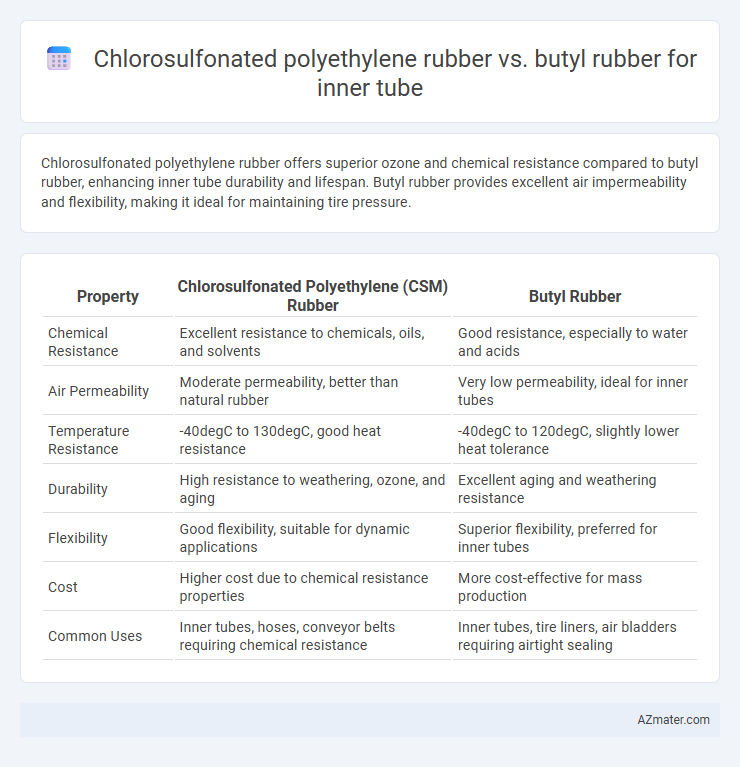Chlorosulfonated polyethylene rubber offers superior ozone and chemical resistance compared to butyl rubber, enhancing inner tube durability and lifespan. Butyl rubber provides excellent air impermeability and flexibility, making it ideal for maintaining tire pressure.
Table of Comparison
| Property | Chlorosulfonated Polyethylene (CSM) Rubber | Butyl Rubber |
|---|---|---|
| Chemical Resistance | Excellent resistance to chemicals, oils, and solvents | Good resistance, especially to water and acids |
| Air Permeability | Moderate permeability, better than natural rubber | Very low permeability, ideal for inner tubes |
| Temperature Resistance | -40degC to 130degC, good heat resistance | -40degC to 120degC, slightly lower heat tolerance |
| Durability | High resistance to weathering, ozone, and aging | Excellent aging and weathering resistance |
| Flexibility | Good flexibility, suitable for dynamic applications | Superior flexibility, preferred for inner tubes |
| Cost | Higher cost due to chemical resistance properties | More cost-effective for mass production |
| Common Uses | Inner tubes, hoses, conveyor belts requiring chemical resistance | Inner tubes, tire liners, air bladders requiring airtight sealing |
Overview of Chlorosulfonated Polyethylene Rubber
Chlorosulfonated polyethylene rubber (CSM), also known as Hypalon, is a synthetic elastomer renowned for its exceptional resistance to heat, ozone, chemicals, and weathering, making it highly durable in demanding conditions. Its molecular structure incorporates chlorine and sulfonyl chloride groups, providing superior impermeability and flexibility for inner tube applications. Compared to butyl rubber, CSM offers enhanced chemical resistance and longevity, though butyl rubber excels in gas impermeability and elasticity, making each material suitable for different performance priorities in inner tube manufacturing.
Key Properties of Butyl Rubber
Butyl rubber offers exceptional air impermeability and chemical resistance, making it an ideal material for inner tubes where maintaining consistent tire pressure is critical. It exhibits excellent flexibility and low gas permeability due to its saturated polymer backbone, which outperforms chlorosulfonated polyethylene rubber in preventing air leaks. The superior damping properties and abrasion resistance of butyl rubber enhance durability and ride comfort in automotive and bicycle inner tubes.
Chemical Resistance Comparison
Chlorosulfonated polyethylene (CSM) rubber exhibits superior chemical resistance to oils, solvents, and ozone compared to butyl rubber, making it highly suitable for inner tubes exposed to harsh chemical environments. Butyl rubber, while excellent in gas impermeability and resistance to water vapor, shows lower resistance to hydrocarbons, acids, and organic solvents. The enhanced chemical stability of CSM rubber ensures longer durability and performance in aggressive chemical applications for inner tube linings.
Air Retention and Permeability
Chlorosulfonated polyethylene (CSM) rubber exhibits superior air retention and lower gas permeability compared to butyl rubber, making it more effective in maintaining tire pressure over extended periods. The dense molecular structure of CSM reduces the diffusion rate of gases, significantly minimizing air leakage in inner tubes. Butyl rubber, while commonly used for its excellent elasticity and chemical resistance, demonstrates higher permeability, leading to faster pressure loss and more frequent inflation needs.
Temperature Performance and Durability
Chlorosulfonated polyethylene (CSM) rubber exhibits superior temperature resistance, maintaining flexibility and performance in a wide range of temperatures from -40degC to 130degC, making it ideal for inner tubes in extreme environments. Butyl rubber offers excellent air retention and good chemical resistance but has a narrower effective temperature range, typically from -50degC to 90degC. Durability-wise, CSM rubber provides enhanced resistance to ozone, weathering, and abrasion, resulting in longer lifespan under harsh conditions compared to butyl rubber, which excels in impermeability but may degrade faster when exposed to UV and chemicals.
Flexibility and Elasticity Differences
Chlorosulfonated polyethylene (CSM) rubber offers superior chemical resistance and durability but exhibits lower flexibility and elasticity compared to butyl rubber. Butyl rubber provides excellent elasticity and superior air retention, making it highly flexible and ideal for inner tubes requiring consistent deformation recovery. The elasticity of butyl rubber ensures better shock absorption and adaptability to tire shape changes, whereas CSM rubber prioritizes resistance to abrasion and ozone over stretchability.
Manufacturing and Processing Considerations
Chlorosulfonated polyethylene (CSM) rubber offers superior weather and chemical resistance, making it well-suited for inner tubes exposed to harsh environments, whereas Butyl rubber provides excellent impermeability to gases and superior air retention, critical for maintaining tire pressure. Manufacturing CSM inner tubes involves careful handling of its chlorosulfonyl groups during vulcanization to ensure optimal cross-linking and durability, while Butyl rubber processing emphasizes extrusion and curing techniques to maximize elasticity and minimize air permeability. Both materials require tailored compounding and curing processes to balance flexibility, strength, and resistance, impacting production costs and equipment specifications.
Cost Assessment and Availability
Chlorosulfonated polyethylene (CSPE) rubber generally incurs higher production costs compared to butyl rubber due to its complex manufacturing process and the incorporation of chlorine and sulfur compounds. Butyl rubber remains more cost-effective and widely available, benefiting from established large-scale production and extensive supply chains, which ensures consistent availability for inner tube manufacturing. The superior chemical resistance of CSPE may justify its higher cost in specialized applications, but for standard inner tubes, butyl rubber is preferred for its affordability and easier procurement.
Suitability for Inner Tube Applications
Chlorosulfonated polyethylene (CSM) rubber offers excellent resistance to ozone, weathering, and chemicals, making it highly suitable for inner tubes exposed to harsh environmental conditions. Butyl rubber provides superior air retention and flexibility, ensuring long-lasting inflation and resilience against punctures in inner tubes. Both materials excel in durability, but butyl rubber's low air permeability makes it the preferred choice for inner tube applications requiring consistent inflation and airtight performance.
Summary: Which Rubber is Better for Inner Tubes?
Chlorosulfonated polyethylene (CSM) rubber offers superior chemical resistance, excellent weatherability, and high durability, making it ideal for inner tubes exposed to harsh environments and extreme temperatures. Butyl rubber provides exceptional air retention and flexibility, which enhances the inner tube's airtightness and shock absorption under varying pressure conditions. For applications prioritizing airtightness and comfort, butyl rubber is preferable, while CSM rubber suits more demanding environmental resistance and longevity needs.

Infographic: Chlorosulfonated polyethylene rubber vs Butyl rubber for Inner tube
 azmater.com
azmater.com